 W
WIn association football, an assistant referee is an official empowered with assisting the referee in enforcing the Laws of the Game during a match. Although assistants are not required under the Laws, at most organised levels of football the match officiating crew consists of the referee and at least two assistant referees. The responsibilities of the various assistant referees are listed in Law 6, "The Other Match Officials". In the current Laws the term "assistant referee" technically refers only to the two officials who generally patrol the touchlines, with the wider range of assistants to the referee given other titles.
 W
WAssociation football, more commonly known as simply football or soccer, is a team sport played with a spherical ball between two teams of 11 players. It is played by approximately 250 million players in over 200 countries and dependencies, making it the world's most popular sport. The game is played on a rectangular field called a pitch with a goal at each end. The object of the game is to outscore the opposition by moving the ball beyond the goal line into the opposing goal. The team with the higher number of goals wins the game.
 W
WA football, soccer ball, football ball, or association football ball is the ball used in the sport of association football. The name of the ball varies according to whether the sport is called "football", "soccer", or "association football". The ball's spherical shape, as well as its size, weight, and material composition, are specified by Law 2 of the Laws of the Game maintained by the International Football Association Board. Additional, more stringent standards are specified by FIFA and subordinate governing bodies for the balls used in the competitions they sanction.
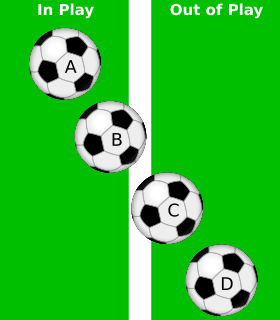 W
WThe ball in and out of play is the ninth law of the Laws of the Game of association football, and describes to the two basic states of play in the game.
 W
WThe Cambridge Rules were several formulations of the rules of football made at the University of Cambridge during the nineteenth century. One of these codes, dating from 1863, had a significant influence on the creation of the original Laws of the Game of the Football Association.
 W
WA corner kick is the method of restarting play in a game of association football when the ball goes out of play over the goal line, without a goal being scored and having last been touched by a member of the defending team. The kick is taken from the corner of the field of play nearest to where it went out. Corners are considered to be a reasonable goal scoring opportunity for the attacking side, though not as much as a penalty kick or a direct free kick near the edge of the penalty area.
 W
WIn association football, diving is an attempt by a player to gain an unfair advantage by falling to the ground and possibly feigning an injury to give the impression that a foul has been committed. Dives are often used to exaggerate the amount of contact present in a challenge. Deciding on whether a player has dived is often very subjective, and one of the most controversial aspects of football discussion. Players do this so they can receive free kicks or penalty kicks, which can provide scoring opportunities, or so the opposing player receives a yellow or red card, giving their own team an advantage. Diving is also known as simulation, Schwalbe, and, in North America, flopping.
 W
WA dropped-ball is a method of restarting play in a game of association football. It is used when play has been stopped due to reasons other than normal gameplay, fouls, or misconduct. The situations requiring a dropped-ball restart are outlined in Law 8 and Law 9 of the Laws of the Game; Law 8 also contains the dropped-ball procedure.
 W
WIn the sport of association football, fouls and misconduct are acts committed by players which are deemed by the referee to be unfair and are subsequently penalised. An offence may be a foul, misconduct or both depending on the nature of the offence and the circumstances in which it occurs. Fouls and misconduct are addressed in Law 12 of the Laws of the Game.
 W
WA free kick is a method of restarting play in association football. It is awarded after an infringement of the laws by the opposing team.
 W
WIn sport, a goal may refer to either an instance of scoring, or to the physical structure or area where an attacking team must send the ball or puck in order to score points. The structure of a goal varies from sport to sport, and one is placed at or near each end of the playing field for each team to defend. For many sports, each goal structure usually consists of two vertical posts, called goal posts, supporting a horizontal crossbar. A goal line marked on the playing surface between the goal posts demarcates the goal area. Thus, the objective is to send the ball or puck between the goal posts, under or over the crossbar, and across the goal line. Other sports may have other types of structures or areas where the ball or puck must pass through, such as the basketball hoop.
 W
WA goal kick, called a goalie kick in some regions, is a method of restarting play in a game of association football. Its procedure is dictated by Law 16 of the Laws of the Game.
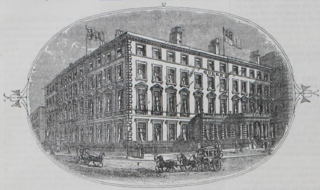 W
WThe International Football Confererence was a meeting of the four football associations of the Home Nations -- England's Football Association, the Scottish Football Association (SFA), the Football Association of Wales (FAW) and the Irish Football Association (IFA) -- held at the Queen's Hotel, Manchester, on 6 December 1882. A precursor to the International Football Association Board, the meeting's major purpose was to address inconsistencies between the laws of the various associations, particularly between England and Scotland. Among the changes resulting from the conference were:the throw-in had to be taken from over the head with two hands the use of a crossbar was made mandatory the kickoff had to be kicked forwards the award of an automatic goal for handball by an opponent that prevented a goal was eliminated it was no longer possible to be offside from a corner-kick the boundary of the field of play should be marked by a touch line as well as by flags
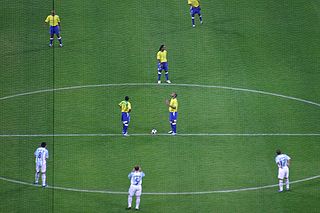 W
WA kick-off is the method of starting and, in some cases, restarting play in a game of association football. The rules concerning the kick-off are part of Law 8 of the Laws of the Game.
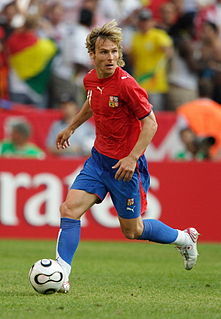 W
WIn association football, kit is the standard equipment and attire worn by players. The sport's rules specify the minimum kit which a player must use, and also prohibit the use of anything that is dangerous to either the player or another participant. Individual competitions may stipulate further restrictions, such as regulating the size of logos displayed on shirts and stating that, in the event of a match between teams with identical or similar colours, the away team must change to different coloured attire.
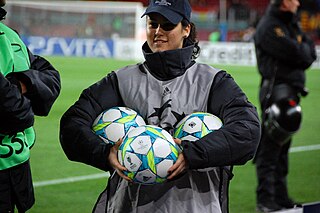 W
WThe multiball system in football permits a match immediately to resume with another ball when the original match ball goes out of play.
 W
WOffside is one of the laws of association football, codified in Law 11 of the Laws of the Game. The law states that a player is in an offside position if any of their body parts, except the hands and arms, are in the opponents' half of the pitch, and closer to the opponents' goal line than both the ball and the second-last opponent.
 W
WThe penalty area or 18-yard box is an area of an association football pitch. It is rectangular and extends 16.5m to each side of the goal and 16.5m in front of it.
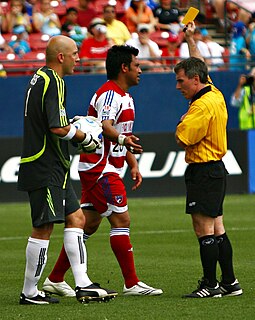 W
WPenalty cards are used in many sports as a means of warning, reprimanding or penalising a player, coach or team official. Penalty cards are most commonly used by referees or umpires to indicate that a player has committed an offence. The official will hold the card above his or her head while looking or pointing towards the player that has committed the offence. This action makes the decision clear to all players, as well as spectators and other officials in a manner that is language-neutral. The colour or shape of the card used by the official indicates the type or seriousness of the offence and the level of punishment that is to be applied. Yellow and red cards are the most common, typically indicating, respectively, cautions and dismissals.
 W
WA penalty kick is a method of restarting play in association football, in which a player is allowed to take a single shot on the goal while it is defended only by the opposing team's goalkeeper. It is awarded when a foul punishable by a direct free kick is committed by a player in their own penalty area. The shot is taken from the penalty mark, which is 11 m from the goal line and centred between the touch lines.
 W
WA football pitch is the playing surface for the game of association football. Its dimensions and markings are defined by Law 1 of the Laws of the Game, "The Field of Play". The pitch is typically made of natural turf or artificial turf, although amateur and recreational teams often play on dirt fields. Artificial surfaces must be green in colour.
 W
WThe referee is the person responsible for enforcing the Laws of the Game (LOTG) during an association football match. He or she is the final decision-making authority on all facts connected with play, and is the only official on the pitch with the authority to start and stop play and impose disciplinary action against players during a match. At most levels of play the referee is assisted by two assistant referees, who are empowered to advise the referee in certain situations such as the ball leaving play or infringements of the Laws of the Game occurring out of the view of the referee; however, the assistant referees' decisions are not binding and the referee has authority to overrule an assistant referee. At higher levels of play the referee may also be assisted by a fourth official who supervises the teams' technical areas and assists the referee with administrative tasks, and, at the very highest levels, additional assistant referees and/or video assistant referees.
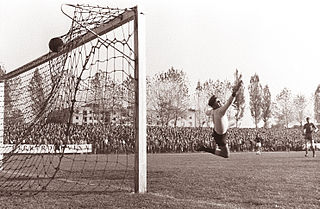 W
WIn games of association football teams compete to score the most goals during the match. A goal is scored when the ball passes completely over a goal line at either end of the field of play between two centrally positioned upright goal posts 24 feet (7.32 m) apart and underneath a horizontal crossbar at a height of 8 feet (2.44 m) — this frame is itself referred to as a goal. Each team aims to score at one end of the pitch, while preventing their opponents from scoring at the other. Nets are usually attached to the goal frame to catch goalscoring balls, but the ball is not required to touch the net.
 W
WThe Sheffield Rules was a code of football devised and played in the English city of Sheffield between 1858 and 1877. The rules were initially created and revised by Sheffield Football Club, with responsibility for the laws passing to the Sheffield Football Association upon that body's creation in 1867. The rules spread beyond the city boundaries to other clubs and associations in the north and midlands of England, making them one of the most popular forms of football during the 1860s and 1870s.
 W
WA technical area in association football is an area which a manager, other coaching personnel, and substitute are allowed to occupy during a match.
 W
WJohn Charles Thring, known during his life as "Charles Thring" or "J. C. Thring", was an English clergyman and teacher, notable for his contributions to the early history of association football.
 W
WA throw-in is a method of restarting play in a game of association football when the ball has exited the side of the field of play. It is governed by Law 15 of The Laws Of The Game.
 W
WThe video assistant referee (VAR) is an assistant referee in association football who reviews decisions made by the head referee with the use of video footage and headset for communication specifically in order to minimize human errors causing substantial influence on match results.